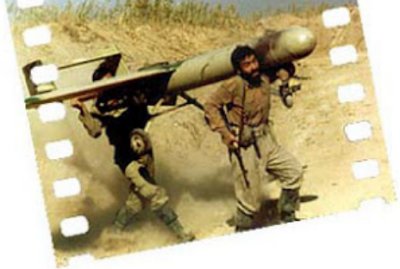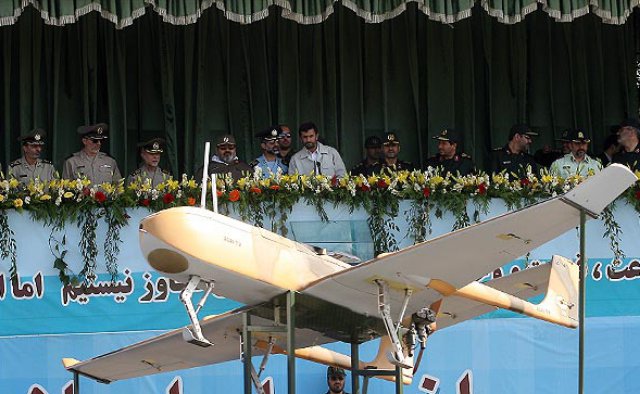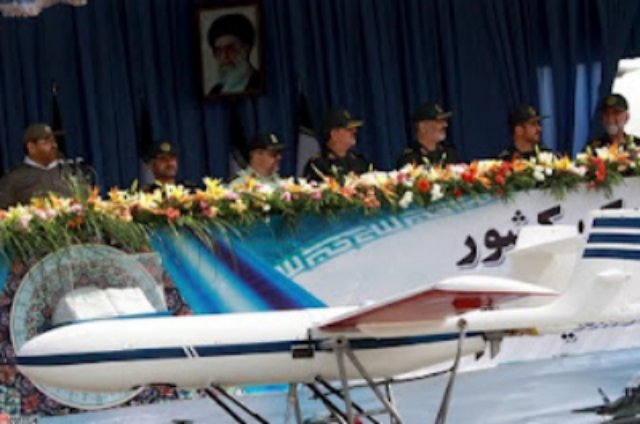The Mohajer family of reconnaissance and surveillance UAS emerged during the later stages of the Iran-Iraq war as improvised UAS but have since evolved. Mohajer means “Migrant”. Early model Mohajers were some of the first ever use of UCAVs in combat. 253 Mohajers have been produced by the Qods Aviation Industry as of 2006-2007.
Early-model Mohajers feature the same basic design with a cigarette shaped fuselage with wings mounted at the high fuselage point and slightly to the rear. The wings themselves have a constant chord. Only the Mohajer-4 differs in this regard. All models have a joined double tail-boom. Control surfaces are found on the main wings as well as the tail-planes. Most models are fitted with landing skids. The Mohajer family uses an unknown powerplant.
The Mohajer can be launched from the usual range of JATO/RATO Pneumatic launch ramps usually associated with Iran’s other UAS, except perhaps the shortest. Recovery is either conventional landing via skids or by parachute.
 The Mohajer-1 saw action during the later stages of the Iran-Iraq war where it was launched from speedboats to provide battlefield surveillance for Iranian offensives. Unlike later Mohajers, it featured a tricycle landing gear that would theoretically give it a conventional take-off capability. It had a range of 30 km while it’s payload included a static nose mounted camera and up to six PG-7 rockets (three under each wing).
The Mohajer-1 saw action during the later stages of the Iran-Iraq war where it was launched from speedboats to provide battlefield surveillance for Iranian offensives. Unlike later Mohajers, it featured a tricycle landing gear that would theoretically give it a conventional take-off capability. It had a range of 30 km while it’s payload included a static nose mounted camera and up to six PG-7 rockets (three under each wing).
The Mohajer-2 shares the same basic design as the Mohajer-1, but adds what can only be explained as carry handles have been mounted on either side of the fuselage just forward and below the leading edge of the wing. The wheels meanwhile have been replaced with skids. It is powered by an unknown 25 hp engine. One possible candidate is the WAE-342 which is also used on the Ababil UAS. One large increase in capability compared to the Mohajer-1 comes in the addition of an auto-pilot with a real-time data uplink/downlink.
Mounted in the front of the fuselage is a new payload bay which can carries a traversable mount for TV or FLIR cameras. Also carried is a line-scanner that is advertised as being able to provide 1-meter resolution at an altitude of 5 km. Some models also have a static, forward facing camera mounted in the front of the fuselage.
Also known as the “Dorna”, the Mohajer-3 is reported to have wheels, rather then skids which gives it a conventional launch capability. It is reported to have 80% autonomous capability.
The Mohajer-4, also known as the Hodhod, radically from previous designs featuring a larger box-like fuselage compared to the cigarette shape of earlier generations. The wings are now tapered with a upward cranked tip. Meanwhile, the static skids of the Mohajer-2 have been replaced with flexible skids in a tricycle configuration. It also features composite construction.
The Mohajer-4 was reported to have been first tested in February 2002 alongside the Saeqeh target drone. At least two types of engines appear to be in use, though the exact designations are unknown.
The Mohajer-4 appears to use the same TV/FLIR payload as the Mohajer-2. Another similarity between the two models can be found in the presence of a static, forward-facing camera in the nose of some models of the Mohajer-4 as well.
Mohajer-4 Specifications:
- Length: 3.74 km
- Wingspan: 5.3 m
- Height: NA
- Empty Weight: NA
- MTOW: 210 kg
- Payload Weight: NA
- Cruise Speed: 200 km/h
- Endurance: 3 hr
- Range: 150 km
- Ceiling: 4.57 km
- Powerplant: NA
- Payload:NA
Source: The Arkenstone


